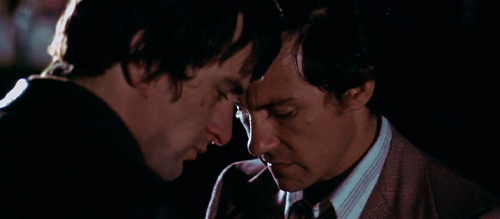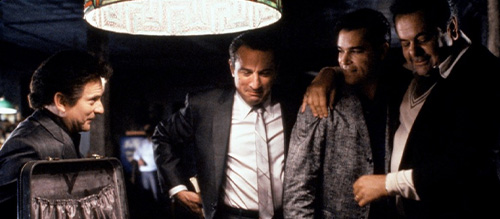Where to Start with Martin Scorsese
To answer the question of where to start with Martin Scorsese, it’s important to understand who Martin Scorsese is. Born Martin Charles Scorsese in 1942, the now famed filmmaker was raised in the Little Italy neighborhood of New York City, and fell in love with film at a young age. After studying film and education at New York University (NYU), he went on to work in the film industry in a variety of positions. He was assistant director and supervising editor for Michael Wadleigh’s Woodstock (1970), a title widely considered to be one of the greatest documentaries in American film. He then went on to direct documentaries of his own, and whilst he has worked in a variety of styles and genres, it is his work on gangster films that he is best known for.
Martin Scorsese was part of the 1970s American auteur wave, and is arguably the most successful of the bunch as an artist. He exemplifies the traditional idea of the film auteur. While Steven Spielberg and George Lucas were working on Hollywood blockbusters, Scorsese was making Taxi Driver, New York, New York, and Raging Bull, three different films that varied with audiences and critics but were undoubtedly Scorsese films. As a lifelong cinephile, his films have always been informed by Hollywood’s past, and have continuously alluded to film history through style, genre, and direct homage. In addition to cinematic fascination, his films have inspiration from his own upbringing. His gangster films reflect the ethos of his Italian youth and culture converging with the big dreams and excesses of American society both in style and content. His editing and cinematography pack as much of a punch as any of the characters, each of whom are driven by powerful performances.
There are all kinds of places to go within the cinema of Martin Scorsese. The goal of this piece is to start at the roots, to really get a handle on what made Scorsese such a great filmmaker and storyteller, and to grow towards his magnum opus. This is Where to Start with Martin Scorsese.
1. Mean Streets (1973)

Mean Streets was Martin Scorsese’s breakout third feature following early recognition for his student films. He wrote the story and collaborated on the screenplay, and this is thought to be the first film upon which he was truly in control of production. In his 1979 book “American Film Now”, critic and author James Monaco described Mean Streets as Scorsese’s one great achievement, noting its status as a personal and original film (154).
Harvey Keitel stars as a small-time gangster in Little Italy, and the character’s practical outlook at the beginning of the film speaks to Scorsese’s own views on Catholicism: “You don’t make up for your sins in church. You do it in the streets. You do it at home. The rest is bullshit and you know it.” Keitel’s Charlie struggles with living his best on the streets, his problems exacerbated by Robert De Niro’s character Johnny. The film is rough around the edges, but brimming with style. The red lights of a bar and street-level gangsters offer a different look at the gangster genre than Francis Ford Coppola’s The Godfather, released the year prior.
It’s important to see Mean Streets because of how the film works as a foundation for Scorsese’s future work. This was the filmmaker’s first collaboration with Robert De Niro (with whom he’d partner on some of the most iconic films of the era), it was a new take on the gangster genre, it took the then-unusual route of featuring hip music in its soundtrack, and its narrative truly drives home the tragic nature of the human condition. If you’re a cinephile, this is exactly the kind of movie people like us were gushing over, the latest film from one of the hottest young directors.
2. Italianamerican (1974)

Martin Scorsese has a body of documentary work almost as large as his feature filmography. His best is his most personal, Italianamerican.
Italianamerican is quite simple: Scorsese puts cameras in front of his parents in their New York apartment and interviews them about their lives and the lives of their family. The parents, Charles and Catherine, were the children of immigrants from Sicily. They have such a fascinating perspective on life because of the working class circumstances in which they grew up, and the film shows how people like his parents were able to achieve what they saw as the American dream.
Scorsese’s parents are natural in front of the camera despite Charles’ protestations that Catherine is putting on airs. The two are honest, and give the impression that we’re sitting down beside them in the kitchen to listen to their stories directly. You can almost taste the meatballs and sauce that Catherine cooks – there’s even a recipe for them at the end.
Italianamerican is important as a window into this great director’s work as it allows you to see another side of his creative output; a soft side that aims to tell real stories of everyday people, to blur the lines between film and reality.
3. Goodfellas (1990)

Goodfellas is Martin Scorsese’s greatest creation as a filmmaker, and the result of the perspective that making a documentary film and making a fiction film are the same process.
In this 6-time Oscar-nominated film, Scorsese tells the dramatized true story of half-Irish, half-Italian gangster Henry Hill, based on crime reporter Nick Pileggi’s novel “Wiseguy”. Goodfellas has all the style of Mean Streets, but it’s incredibly polished after nearly two decades of filmmaking experience. The silhouette of the male leads digging a grave against a red light is just as striking as Mean Streets’ club scene, but its darker nature creates a more provocative image.
Ray Liotta is outstanding as Henry Hill, hitting a variety of emotional beats that are capped off by a frantic, paranoid coke binge at the film’s end. Robert De Niro and Joe Pesci are highlights of the cast, but it’s Lorraine Bracco as Henry’s wife Karen who really steals the show. There’s no true star in the ensemble cast, making the place and lifestyle the film’s central focus. Goodfellas presents the allure of the gangster lifestyle, and hits all the beats expected of the gangster genre by the late 1980s when audiences had perhaps seen it all.
Martin Scorsese’s past and future films address similar themes to Goodfellas, but none are quite so compelling visually. The film is dynamic, the editing and cinematography evolving with the characters over the course of the film, and its function as a representation of reality makes it unlike Mean Streets or even genre great The Godfather, the natural performances elevating the film beyond a general desire for unintrusive acting. Catherine Scorsese herself even makes an appearance in a fully improvised scene. When it comes to Martin Scorsese’s filmography, Goodfellas cannot be beat and is a must for anyone seeking the opportunity to experience this great American director’s unique filmmaking for the first time.
Recommended for you: Where to Start with David Lynch
You can’t go wrong watching anything in Martin Scorsese’s filmography, but these three films will give the most insight into this legendary auteur’s interests, background, and outlook on life. Should you take the advice of this piece, then Taxi Driver, Raging Bull, and Casino are great places to go next.

